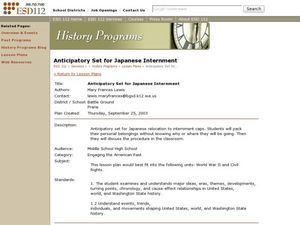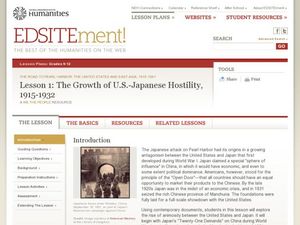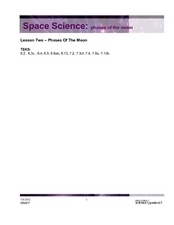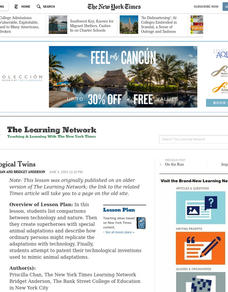Curated OER
"Martial Law in Hawaii After the Attack on Pearl Harbor"
Students explore the concepts of martial law, writ of habeas corpus, due process, discovery and human and constitutional rights during World War II. They assess the roles and responsibilities of government leaders and citizens during...
Curated OER
Do Suspected Enemies Have Rights?
Students investigate the history of Japanese immigration. They complete an online Webquest, explore various websites, answer discussion questions, and locate and read newspaper articles about enemy compatants.
Curated OER
Analyzing Japanese Imperialism
Students engage in a lesson in order to compare and contrast the Imperialism of Japan to that of the United States and Europe. Students can complete a variety of activities that include research questions, reflection from lecture, and...
Curated OER
The Pearl Vocab 1 Word Search Puzzle
In this literacy worksheet, middle schoolers look for the words in the puzzle that are related to the theme of the word search. Spelling skills are worked on.
Curated OER
The Scarlet Letter
Young scholars imagine characters in The Scarlett Letter beyond the ending of the novel. In this literature lesson, students examine the character Pearl and imagine her life at the ages of 14 and 18.
Curated OER
Anticipatory Set for Japanese Internment
Learners simulate Japanese relocation to internment camps after the bombing of Pearl Harbor. They select items to pack that are personally, sentimentally, and financially important to them. They create a Venn diagram comparing and...
US National Archives
WWII: The Atlantic 1939-45 – Battle of the Atlantic
The most dangerous line of attack during World War II wasn't the German planes soaring above Britain, but the U-Boats cutting off their supplies of food and equipment. Learners research the Battle of the Atlantic, the German campaign to...
Curated OER
Pearl Harbor
Young scholars summarize reasons for the U.S. entrance into WWII. They evaluate the pros and cons of those reasons. Students constrict a time line of WWII events. They write in their journals: What role did emotions play in the U.S....
Curated OER
The Growth of U.S.-Japanese Hostility, 1915-1932
Students explore the relationship between Japan and the United States between 1915 and 1932. In this diplomacy instructional activity, students examine the Open Door Policy, 21 Demands, and the invasion of Manchuria by Japan. Students...
Curated OER
Ocean Market
Students research how: The ocean is the source of many materials, from ores mined from its depths to relaxing mineral salts for a bath. Exquisite mother-of-pearl inlay, decorative shells, and pearl jewelry are found in gift shops...
Curated OER
Wartime and the Bill of Rights: The Korematsu Case
Twelfth graders work together in groups to examine the discrimation Japanese Americans felt after the bombing of Pearl Harbor. Using primary source documents, they analyze and discuss the case of Fred Korematsu who was placed in an...
Curated OER
Defining Moments-from the past with lessons for a post 9/11 world
Students use the spreadsheet to determine policy options, establish criteria for the solution, weight the criteria in terms of importance and rate the options relative to each criterion to determine a solution to the problem. They...
Curated OER
Japanese Internment and Korematsu v. US
Students study the internment camps and the trials of the Nisei. They compare the post-Pearl Harbor US with post-9/11 US and evaluate the decision of Korematsu v. US. They synthesize the material and write an assent/dissent opinion on...
Curated OER
"I" Witness to History
Young journalists write diary entries from the point of view of a person involved in a historical event. They focus on including facts, clear narration, and accurate description of the individual's feelings.
Utah Education Network (UEN)
Classical Appeals and War Speeches
Discuss classical appeals of rhetoric through the speeches of Winston Churchill and FDR. Learners read, annotate, and analyze the speeches by the men before using a graphic organizer to track the use of ethos, pathos, and logos.
Curated OER
Dr. Seuss Takes on Charles Lindbergh
Students study the leaders of the isolationist movement within the United States and the causes of the isolationist movement, they recognize and compare the perceptions of both the isolationists within the US and those who took a more...
Curated OER
Space Science: Phases of the Moon
Looking for a terrific instructional activity on the phases of the moon that has lots of good worksheets? With two excellent websites are embedded in the plan, the activity is sure to spark some interest in your astronomy unit. Some...
Curated OER
Juan Verdades
Cement comprehension skills using the strategies in this activity. After reading the story, Juan Verdades by Joe Hays, learners use context clues to answer questions, identify main ideas and details, and sequence events.
Curated OER
Running an Elementary Book Club
Combine reading with fun in order to create lifelong, literary-minded learners who love to read.
Curated OER
Farewell to Manzanar
Examine human resilience across two texts with a detailed unit. Over the course of a week, learners will conduct a close reading of excerpts from Unbroken and Farewell to Manzanar. The resource includes clear procedures for reading and...
Prestwick House
The Scarlet Letter
A is for. . .? Readers test their recall of Nathaniel Hawthorne's The Scarlet Letter by filling in the blanks with words missing from a line of text and by identifying characters and events a crossword puzzle based on the novel.
School Improvement in Maryland
Executive Order
After reading information about Executive Order #9066, class members assume the voice of an 18 year-old Japanese-American born in California and placed in an internment camp. Individuals then craft a letter to President Roosevelt...
Curated OER
Recognizing the Main Idea
Understanding that paragraphs have a main idea expressed in a topic sentence, followed by supporting details in the subsequent sentences is the focus of this presentation. Students practice by reading short paragraphs in 10 slides, and...
Curated OER
Technological Twins
Students list comparisons between technology and nature. Then they create superheroes with special animal characteristics and describe how ordinary persons might replicate the changes with technology.























